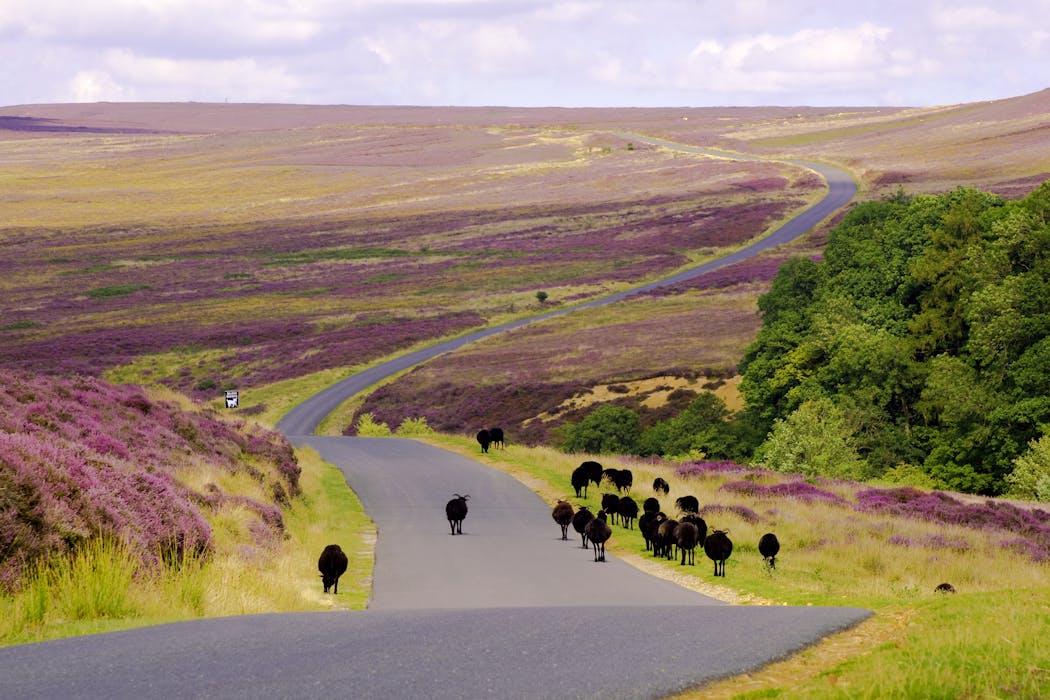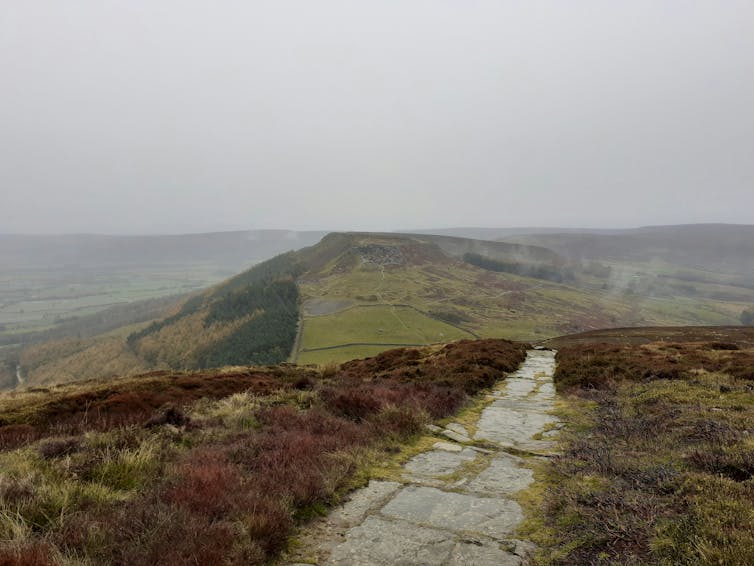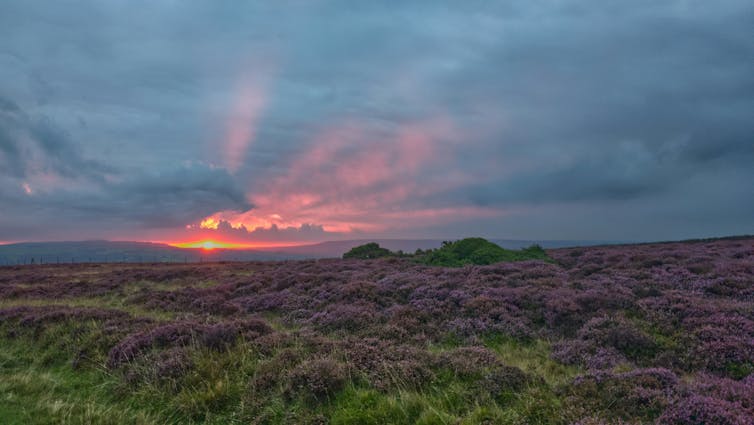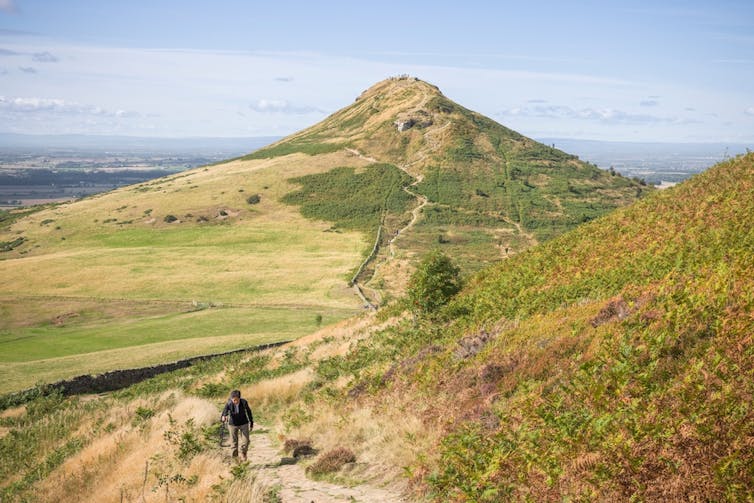Source: The Conversation – UK – By Tom Ratcliffe, Lecturer in Sustainability, Tourism and Heritage Management, York St John University

Thousands of visitors each year explore the landscapes of the UK’s national parks on foot, through walking, rambling, hiking, mountaineering and, more recently, forest bathing.
Many of the earliest advocates for a national park system were notable walkers. They ranged from Lake District conservationists such as William and Dorothy Wordsworth to the ramblers who staged the Kinder Scout trespass in 1932 to demand greater access to the countryside.
I study the relationship between nature and culture in these national parks. As part of my research, I conduct semi-structured walking interviews with communities in the North York Moors national park to further understandings of this relationship. I am part of a wider research team who work with a diverse range of protected landscapes.
Walking, tied to public access and a growing environmental consciousness, grew as an organised leisure activity over the course of the 20th century alongside the development of ideas to protect the UK countryside. Many walkers, often young, working-class people who were members of rambling and hiking clubs, campaigned for greater access to and further protection of the countryside.
The popularity of walking was affirmed with the National Parks and Access to the Countryside Act in 1949, which established England’s rights of way network and founded the UK’s national park system.

Ethan Ridd/Unsplash
The North York Moors, in the north-east of England, was designated a national park in 1952, following this Act. The 1950s then saw a new wave of walkers to the park, encouraged by the increasing use of motor cars, the rise of walking clubs and the spread of youth hostels.
The Lyke Wake Walk was created in 1955 by a local farmer and Cambridge graduate called Bill Cowley. It’s a 42-mile crossing of the North York Moors which became a popular charity walk in the 1960s and 1970s. This increase in walkers brought controversy at the time, especially among the farming population, because of the levels of erosion it was causing. At its peak, 10,000 people crossed the moors each year, not always on public rights of way. Challenge walks were very new back then and most of the people attempting it were inexperienced. Two mountain rescue teams were formed as a result of lost and distressed walkers.
Today, it is still a celebrated “challenge” walk undertaken by ramblers and runners. And 2025 marks the 70th anniversary of the first set of ramblers to successfully cross the park.
Walking through modern parks
The national park’s modern history is closely tied to two other long distance footpaths: the Cleveland Way and the Coast to Coast walk. Alec Falconer, one of the founding members of the Middlesbrough Rambling Club campaigned for a long distance walk around the periphery of the North York Moors. Thanks to his work, the Cleveland Way was established in 1969.
This was the country’s second largest trail at the time, following the establishment of the Pennine Way in 1965. Up to 2,000 hikers complete the whole trail each year.
Created by guidebook author Alfred Wainwright, the Coast to Coast walk is one of the UK’s most popular long-distance footpaths and runs across this national park. Some 6,000 people a year walk the trail, which brings many international visitors to the park. Restoration and conservation work is currently ongoing as this walk is upgraded to a national trail.

Andy Carne/Unsplash
With the gradual expansion of tourism in the North York Moors since its national park designation in the 1950s and the increasing popularity of these footpaths, more pressure has been put on the landscape through walking. Paths have been eroded in places with the responsibility of maintenance falling upon the national park authority and landowners. A ranger I spoke to during a walking interview as part of my research commented on the condition of a footpath on Fylingdales Moor:
“I know this path very well … this used to be horrendously boggy and the park is doing a damn good job here … you are on the old smugglers trod route.”
Today, walking is one of the most popular activities in the park. Some 6.5 million people in 2024 visited the park for a short or long walk. The park offers an expansive network of public rights of way alongside extensive open access land.
Some paths make use of the park’s industrial heritage, using old rail tracks as walking routes, such as the Cinder Track which is a disused railway and now a footpath and cycle track through the park from Scarborough to Whitby.
Walking in this national park plays a vital role in supporting the wellbeing of nearby urban communities, such as Middlesborough and Scarborough. Residents from disadvantaged backgrounds access the park to improve their physical and mental health and the North York Moors National Park Authority aims to build on this through the growing popularity of NHS programmes which socially prescribe nature-based activities.
As a support worker from the local community told me: “Getting out here in that fresh air. It is relaxation and peacefulness. It brings a different mindset connecting with nature. I get something to take home.”
Since the COVID-19 pandemic, more people have come to appreciate the importance of visiting the national park for health-related reasons. Not only for its extensive heather moorland, the largest in England and Wales, but also for its distinctive coastal villages and other special qualities of the park. Yet many who visit do not realise that the North York Moors landscape is not natural – much of the heather moorland is farmed and managed by private landowners for shooting and farming purposes.

Paul Maguire/Shutterstock
In a time of ecological uncertainty, walking is a vital means of sensing and interpreting a countryside in transition – marked by biodiversity loss, a deepening climate crisis and emerging landscape recovery and rewilding projects that reimagine the relationship between people and land.
Through walking, new creative responses can emerge to address sustainability challenges, including social inequalities, climate and biodiversity emergencies, across the UK’s protected landscapes.
Many of the debates around walking that shaped the original designation of the UK’s national park system remain relevant today – particularly those concerning access and the right to roam, the balance between land conservation, protection and development and approaches to moorland management and land use.
Walking through the moors enable us to engage deeply, respectfully, and reflectively with these ongoing discussions and consider the future of the UK’s uplands.
Looking for something good? Cut through the noise with a carefully curated selection of the latest releases, live events and exhibitions, straight to your inbox every fortnight, on Fridays. Sign up here.
![]()
Tom Ratcliffe works for York St John University. Tom received funding from the Arts and Humanities Research Council for his PhD thesis. Tom is affiliated with the North York Moors Association.
– ref. Walking through the North York Moors National Park – a place of adventure, conservation and healing – https://theconversation.com/walking-through-the-north-york-moors-national-park-a-place-of-adventure-conservation-and-healing-266929
